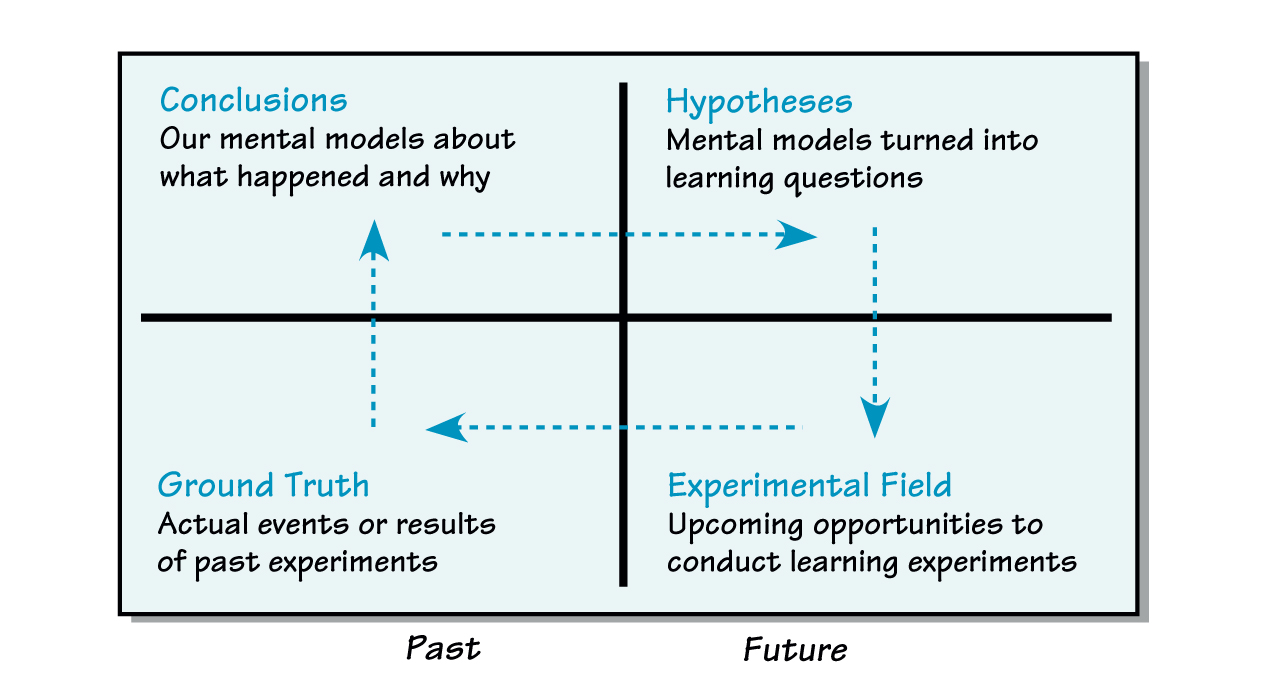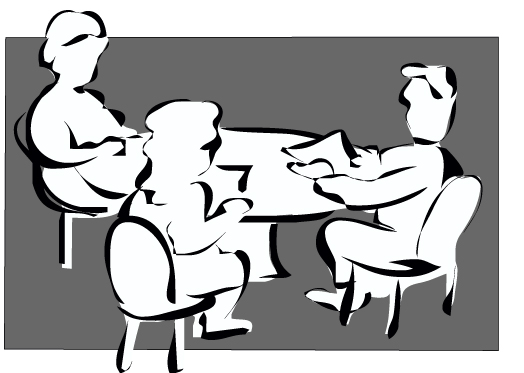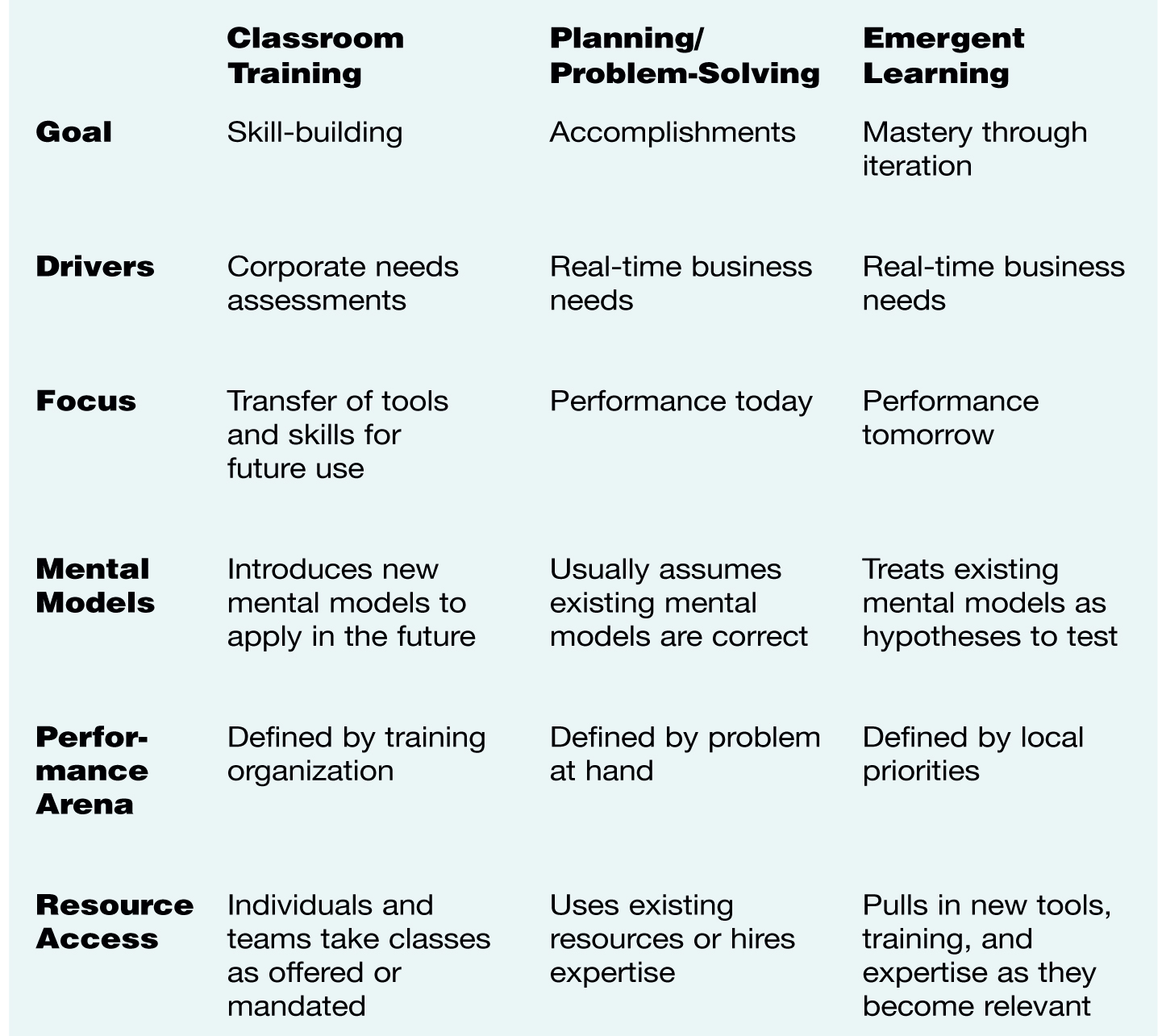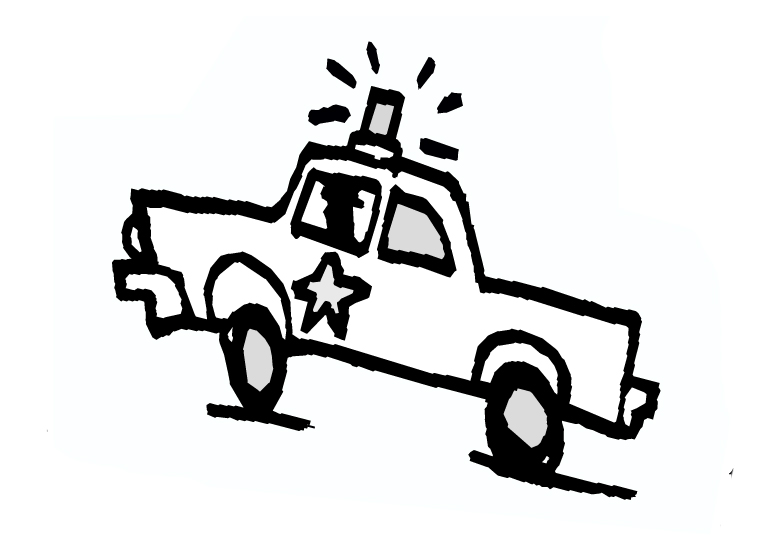Afundamental paradox of working in today’s fast-paced organizations is that we don’t have time to make mistakes, but we don’t have time to avoid them either. Our jobs have become a blur. We cringe when we see ourselves falling into the same traps over and over. We groan in frustration when we find out that three business units are deep in the throes of reinventing the same wheel. Or we experience a stunning success, but we don’t have the time to figure out what made it possible.
In an attempt to capture learnings, we make our best efforts to take time out to reflect. For example, we may institutionalize project “postmortems,” or have an internal consultant study and document lessons learned. Or, we may focus on the “front end” by conducting training in balancing inquiry and advocacy, understanding systems archetypes, or engaging in dialogue.
All of these approaches have the potential to shift us out of our reactive ruts. But they do not automatically become part of an organization’s working habits; we must devote time, resources, and infrastructure to tend to and nurture them. More often than we care to admit, “lessons learned” collect dust on the shelf because we just don’t have the time to translate others’ hard-won insights into our next high-priority project. And sometimes our new reflection skills and techniques are just “out of sync” with our workflow — we don’t have time for them when we need them, and when we do have time, other priorities beckon us.
THE EMERGENT LEARNING PROCESS

“Learning from experience” is mostly done retrospectively. Engaging in emergent learning means taking an intentional, evolutionary approach to learning “through” experience — by conducting iterative experiments using a group’s real work as the experimental field. Taking this approach often produces new and powerful learning simultaneously to making headway on key business issues
Emergent learning practices offer us a pragmatic, low-overhead approach to making the time and space for organizational learning habits to grow. In the process, they help teams and business units develop “islands of mastery,” or growing areas of expertise in their increasingly complex working environments. And the practices help sponsors identify incremental wins and build a business case for the value of organizational learning.
What Is Emergent Learning?

Emergent learning is the ongoing exploration of a locally defined arena of action through intentional, iterative learning experiments. The goal of emergent learning is for a group of people — perhaps a team or business unit — to master performance in arenas of key importance to their business. The focus of these learning experiments might be improving the organization’s ability to fulfill its basic mission (such as, for a police department, reducing crime), managing escalating costs, creating successful strategic alliances, or bringing projects in on time and under budget. An experiment might involve comparing two recent strategic alliances, forming conclusions about these experiences, and testing the conclusions on a new project. Or for a group of project managers, an experiment might mean getting clients involved in projects at different times and in different ways to see how these variables affect the decision-making process But in each case, the two characteristics that distinguish emergent learning from how we usually approach simply “learning from experience” are that it is iterative and intentional. Teams repeat emergent learning experiments in parallel or in close enough succession to be able to compare and contrast performance from instance to instance. They purposefully define experiments in advance of the experience, not in retrospect, as in a “post-mortem.” These intentional iterations make learning from experience active and evolutionary, rather than a static, one-time review.
Simply put, today’s working environments are often too complex and fast moving to give us the time and space we need to focus our full attention on learning. Consequently, the practical reality for many of us is that only those learning practices that require little time will actually take root (see “Rethinking Time” by Peter M. Senge in The Dance of Change, Doubleday/Currency, 1999). By weaving learning into the real-time priorities and real work challenges of a business unit or team, an emergent learning approach bypasses the need to stop what we’re doing in order to learn
In fact, a team may develop extraordinary emergent learning practices without ever thinking of it as “learning.” Emergent learning often looks a lot more like locally driven strategic planning or problem-solving than like what we usually think of as training. Groups self-organize to focus on improving their performance, rather than stepping into a classroom setting where the attention centers on the instructor’s expertise. On the other hand, because of its iterative nature, it differs from what we traditionally think of as planning or problem-solving by focusing on mastery (performance over time), rather than on accomplishment (performance today) (see “Comparing Training, Planning, and Emergent Learning” on p. 3).
Emergent Learning in Practice
Here’s an example of an emergent learning process based on a group’s real work needs and conducted in real time: The executive team of a large regional vocational school expressed its frustration at once again needing to downsize because of escalating costs. In years past, members had rolled up their sleeves and done the painful work of identifying possible staffing and program cuts. When all was said and done, they had at least felt a sense of accomplishment at having taken hard but necessary steps to solve the problem.
After the third downsizing this decade, they made a determined effort to escape from what they had come to see as a vicious cycle by taking steps to shift their focus from short-term crisis resolution to developing long-term solutions through emergent learning.
The team defined an arena on which to focus: its cost structure. Facing obvious and painful failures in trying to solve recurring financial problems, members recognized how little they really understood their costs. They made a commitment to “master” the cost arena — to develop a richer, shared understanding of what drives costs, and to be able to consistently manage them. They had a discussion to articulate the key variables or criteria that would indicate success in this arena.
The team then identified a few repeatable contexts that could easily provide opportunities for reflection: weekly staff meetings and executive reporting. Because these activities were already on their plates, they provided a relatively quick and easy way for team members to test their mental models about what was driving costs. Because they were recurring, the group could easily review the results of experiments that they planned to conduct on a regular basis, and gradually evolve a real mastery of the issue.
This process may look like nothing more than good problem-solving. But it demonstrates a subtle shift from accomplishment to mastery
To get started, team members shared their beliefs and understanding about what contributed to the school’s cost structure. Then they very deliberately turned these statements into hypotheses to test in learning experiments. Each member considered what projects he or she was involved in or what data he or she had that would serve as the basis for conducting experiments. For example, the head of programs was curious about whether his assumptions about the direct relationship between class size, perceived program quality, and costs would hold up. The head of facilities had questions about whether previous cuts in headcount might have actually resulted in increased maintenance costs.
Initially, they simply added brief reviews of cost trends (such as compensation, legal fees, and supplies) to their weekly meetings, and a discussion of 12-month cost patterns to the monthly and quarterly executive reports. Over time, through several iterations, they began to see new relationships and investigate such dynamics as the relationship between facilities maintenance, compensation, and legal costs. In staff meetings, they reflected on the potential causes of changes in costs and described experiments that they had tried. (At one meeting, the head of facilities reported about asking his team what they would do if he went on sabbatical for a year. The creative responses that he got inspired some of his peers to try the same experiment.)
At each iteration, the results of just-completed learning experiments became the “ground truth” on which they reflected in order to plan for the next learning experiments (see “The Emergent Learning Process” on p. 1). With the benefit of their peers’ perspectives, team members teased out unspoken assumptions, lessons learned, and so on. They began to question the measures that they had relied on in the past and realized that they needed more powerful and timely cost indicators. They acknowledged how delays in feedback — in the form of unanticipated cost increases — affected their ability to manage expenses. These sessions inevitably led to new questions and new experiments.
COMPARING TRAINING, PLANNING, AND EMERGENT LEARNING

Beyond Problem-Solving
This process may look like nothing more than good problem-solving. But it demonstrates a subtle shift from accomplishment to mastery. With this new mindset, everyone on the school’s executive team worked under the assumption that they would run through the learning cycle at least several times. Over time, as they cycled through iterations of this process, their learning experiments got more specific and they asked better and better questions. They also developed finer distinctions about costs and the dynamics that cause them to rise. In addition, they identified early indicators that a problem was brewing. As a result, their sense of confidence in being able to tackle something as complex as escalating cost structures grew.
On the other hand, if the team had continued to focus on problem-solving rather than on learning, they might have replaced downsizing with another, perhaps equally short-term, “solution.” By simply abandoning their first approach to the problem, they may have failed to develop a true understanding of why downsizing did not solve the problem. Or they might have chosen to “downsize harder,” triggering even steeper cost problems as the school struggled with the loss of skilled personnel
By taking an emergent learning approach, the team also created a compelling context for drawing on the tools of organizational learning. For example, they began to see that they had fallen into a “siege” mentality regarding saving their favorite function from the chopping block. So the group sought training in balancing inquiry and advocacy, recognizing that their ineffective communication habits were affecting their ability to explore alternative theories and solutions. They also studied systems thinking to begin to grasp the drivers of costs and to understand the behavior of reinforcing processes. In this way, they developed expertise as they needed it and as it made sense for addressing their current business challenges — not as it was deemed necessary by a training department or corporate mandate.

Simplicity and Localness
The best emergent learning practices track a few simple variables within an experimental field that is as local as possible. In the example above, the executive team initially tracked operating costs (variables) within the different departments (experimental fields). Each participant made a series of small changes to the work that they were already doing in these areas.
Over the long term, these intentional, iterative experiments at the operational level often generate new and unpredicted, but remarkably powerful, changes in behavior. For example, the Boston Police Department uses simple three-month charts of major crimes, district-by-district, to understand and influence crime trends, such as a rise in burglaries in a particular neighborhood. Over time,
this disciplined approach to managing crime has inspired district police to go out of their way to meet local teens and attend community meetings, not because it’s their job, but because they see that making a personal connection is critical to grasping what is fundamentally driving trends in crimes.
The U. S. Army’s After Action Reviews (AARs), which emerged from its intensive two-week training simulations in the Mojave Desert, are another example of a practice that is so simple and local in design that it spread on its own, without being mandated from above. In an AAR, soldiers take an hour after a military encounter (simulated or real) to analyze what caused any differences between what they intended to accomplish and what actually happened. In addition, they identify strengths to sustain and weaknesses to improve in the next encounter. AARs have become so ingrained in the organization’s culture that almost anything is now seen as a learning opportunity—, “Let’s AAR that.”
Committing to Learning Experiments
As shown in these examples, opportunities for emergent learning are everywhere. The seeds for it can be found in what Barry Dym calls “forays” — small, local initiatives that are exceptions to the more established patterns of working together (see “Forays: The Power of Small Changes” by Barry Dym, V9N7). They can also spring up in “communities of practice” — informal groups that join together to develop a shared repertoire of resources. To reap the benefits of emergent learning, members of these groups must shift from following the traditional professional association model — holding abstract conversations based on expert presentations — to making the commitment to study their own performance in a concretely defined field of experiments (see “Communities of Practice: Learning as a Social System” by Etienne Wenger, V9N5).
Nortel Networks’ Competitive Analysis Guild (CA Guild) is an apt example of a self-organized community of practice that has been able to make that shift. The CA Guild gathers members from across organizational boundaries to share knowledge about Nortel’s competitors and build their competitive intelligence skills. Guild membership outlives project assignments and creates a “virtual neighborhood” of likeminded individuals.
Some Guild practices look like those of traditional professional associations: monthly meetings with formal presentations and a Web site with announcements of upcoming events. But the Guild has also created some activities that are developing emergent qualities. For example, any Nortel Networks employee can use the Guild Web site to seek information about competitors from members. The sharing of questions and answers through the network is an iterative process. Participants have reported that they have become more sensitive to early indicators of important actions by competitors.
The Guild also views industry trade shows as a natural experimental field. At any given industry trade show, there may be 30 or more Nortel Networks employees wandering the floor. The Guild developed a procedure to focus these employees on a learning agenda. After each show, not only does the Guild take away good data, but it also reflects on and refines its trade-show practices. Over time and with iterations, this approach turns good intelligence-gathering into emergent learning.
Islands of Mastery
Peter Senge has commented that, “I have never seen a successful organizational learning program rolled out from the top. Not a single one. Conversely, every change process that I’ve seen that was sustained and that spread has started small. Usually these programs start with just one team” (Fast Company, May 1999). Emergent learning builds the organizational learning “habit” from the bottom up, by focusing a team on mastering performance in an arena that is important to them. The venue may be big and “strategic,” such as demonstrating leadership during a merger, or it may be small and “tactical,” such as planning food for faculty meetings. Whatever the level, as the team disciplines itself to focus its attention on its performance in this one arena in an iterative way, a lot of what previously seemed like erratic, unpredictable results can begin to make sense (see “Conducting Learning Experiments”).
Emergent learning builds the organizational learning “habit” from the bottom up
And so, an island of mastery begins to emerge from the sea of complexity. And as one arena of action starts to make sense, the group naturally expands its field of inquiry into other arenas. In turn, team members’ confidence in being able to master their business challenges grows. They become better able to clarify their priorities, articulate their own theory of success, test their hypotheses, and make a strong case in support of their thinking.
This self-reinforcing cycle of curiosity and growing competence can have an almost addictive quality — it makes people thirsty to learn more. As people develop a learning discipline and begin to search for fundamental solutions, they almost automatically take a systems perspective, collaborate more effectively with others, and challenge their existing mental models.
In this way, pairing emergent learning practices with traditional training can help the tools and techniques of organizational learning find a natural home. As internal and external practitioners, we can look for opportunities to turn events and projects that we are currently working on into learning experiments. We can do more to identify and support naturally occurring emergent learning practices, and make it a priority to notice and publicize results. And we can also help business units, teams, and communities of practice create new emergent learning practices. In the process, we will build natural advocates for organizational learning, complete with their own compelling stories to tell.
CONDUCTING LEARNING EXPERIMENTS
2. Articulate a few simple key variables or criteria for success in that arena; for example, shared understanding, measured by tracking the agreements that are kept and those that fall apart.
3. Identify processes or events that are already on your plate and that repeat on a fairly regular basis, such as video-conferenced project meetings.
4. Start with a hypothesis, mental model, or question about success in that arena; for example, “If we actively make room for dissenting opinions up front, the quality of follow-through on agreements will increase.”
5. Define a simple experiment to test your hypothesis that you can “slip” into an existing event or project without a lot of extra design effort; for instance, each time a decision is about to be reached, you (as a team member) can ask, “Is there anyone who doesn’t feel heard on this yet?” Make some predictions about what you expect to see as results; for example, within two meetings there will be an absence of the usual “Well, I didn’t really agree with that anyway” when a slip-up is discovered.
6. Plan when, how, and with whom you will study the results. Meet between repetitions of selected experiments so that you can assess the results and apply what you learn to the next iteration. For example, as a part of planning each meeting, three project managers may briefly review the “ground truth” from the last experiment and discuss their conclusions. In this case, the number of agreements kept may have improved, but now the meetings run long.
7. Iterate the process, starting with step four. “So, given our understanding of how time constraints and the keeping of agreements are related, how can we adjust our hypothesis about how to achieve both?”
